
Berlin's (hi)story
From a settlement to a city
The two settlements that formed the basis for the city of Berlin were Cölln, located on the present-day site of Museum Island, and Berlin, on the northern banks of the Spree. Both were already established by the 13th century. Cölln was first referenced on 28th of October, 1278. This date is accepted as the date Berlin was established. In 1307 the two settlements of Cölln and Berlin were unified to form one town.
Following unrest in 1451, elector prince Friedrich II declared that Berlin would be his official residence. The town suffered again and again from fires, plagues, and wars, and it was only under the rule of Friedrich Wilhelm (1640 - 1683) that the town started to enjoy a period of stability and prosperity. The city was fortified and the first opulent buildings were constructed. You can get a good idea of what this looked like by walking along Unter den Linden, a major boulevard in the centre of modern-day Berlin.
Royal residence and rapid growth
In 1701, following the coronation of elector prince Friedrich III as King Friedrich I of Prussia, Berlin was elevated to the status of royal residence and capital city. Numerous, famous buildings were constructed during this period. Between 1740 and 1786, under the rule of both King Friedrich Wilhelm I (the Soldier King) and his successor Friedrich II (Frederick the Great), Berlin developed into Prussia's leading industrial city.
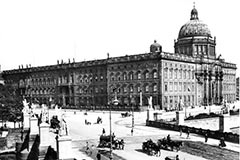 Frederick the Great commissioned the master builder Knobelsdorff to redesign the city's architecture. The size of the population climbed to over 150,000. Frederick the Great had a particular interest in sponsoring the sciences, art, and culture. Berlin became a centre for the Enlightenment.
Frederick the Great commissioned the master builder Knobelsdorff to redesign the city's architecture. The size of the population climbed to over 150,000. Frederick the Great had a particular interest in sponsoring the sciences, art, and culture. Berlin became a centre for the Enlightenment.
From 1806-1808 the city was occupied by Napoleon's troops; following the Battle of the Nations in Leipzig in 1814, the Quadriga (four-horsed chariot), which Napoleon had removed, was returned to its place on the top of the Brandenburg Gate. Over the following decades, a number of classical buildings were erected by Schinkel, and gorgeous park areas were created by Lenné. From the mid-19th century the economy boomed and so did the population.
Capital of the German Empire
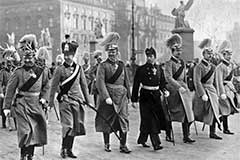 At the time the German Empire was founded in 1871, Berlin had a population of 800,000. Wilhelm I of Prussia (1861 - 1888) was crowned German Emperor. Berlin became the capital of the German empire, and by 1895 had over 1.5 million inhabitants. The last German emperor, Wilhelm II (1888 - 1918) went into exile following Germany's defeat in the First World War.
At the time the German Empire was founded in 1871, Berlin had a population of 800,000. Wilhelm I of Prussia (1861 - 1888) was crowned German Emperor. Berlin became the capital of the German empire, and by 1895 had over 1.5 million inhabitants. The last German emperor, Wilhelm II (1888 - 1918) went into exile following Germany's defeat in the First World War.
The heavy defeat of the First World War created a serious crisis for both Germany and for Berlin, and resulted in the creation of the first German Republic. Despite the economic hardships and civil unrest of the 1920s, Berlin blossomed into a cultural metropolis. Its revolutionary theatre productions, stylish film premieres, and risqué varietés were at the heart of the Golden Twenties.
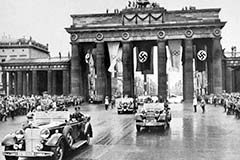 In 1933, Adolf Hitler became German Chancellor. After seizing power, Hitler initiated a programme of persecution against Jews, communists, homosexuals, political opponents, and many others. The darkest chapters in Berlin's history had begun.
In 1933, Adolf Hitler became German Chancellor. After seizing power, Hitler initiated a programme of persecution against Jews, communists, homosexuals, political opponents, and many others. The darkest chapters in Berlin's history had begun.
The summer Olympic Games took place in Berlin in 1936, with few people realising Hitler's delusions of grandeur. When the Second World War began on 1st September, 1939, Berlin's population had swelled to 4.5 million. The bombs started to reign down on the city in 1943 and led to the city's capitulation on 8th May, 1945. At least a third of the city's historic buildings and living-space had been destroyed.
Reconstruction and division
After the terror of the Nazi dictator and the end of the war, the city lay in ruins. The population had almost halved. The city was divided into four sectors, each under the control of one of the victorious Allied powers. The east of the city was controlled by the Soviets, the south-west by the USA, the west by Great Britain and the north-west by France.
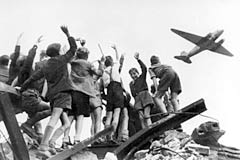 From 25th June, 1948, the three western sectors were blockaded by the Soviets. The Allies' “Berlin Airlift“ kept the city going by flying in supplies of food and other provisions for a total of 324 days. The locals nicknamed the Allied planes “Rosinenbombern“ (raisin bombers). The blockade finally ended on 12th May, 1949.
From 25th June, 1948, the three western sectors were blockaded by the Soviets. The Allies' “Berlin Airlift“ kept the city going by flying in supplies of food and other provisions for a total of 324 days. The locals nicknamed the Allied planes “Rosinenbombern“ (raisin bombers). The blockade finally ended on 12th May, 1949.
When the German Democratic Republic was founded on 7th October, 1949, East Berlin became the capital of the GDR. The government of the GDR moved its location to the eastern half of the city. At that time people could still travel across to the west, for example, to work, without a problem.
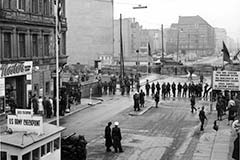 The division of the city was set in stone when the Berlin Wall was erected on 13th August, 1961. From then on, it became impossible for those living in the East Berlin to visit family members in West Germany or to commute to West Berlin. It was only after John F. Kennedy visited the city in 1963 that a limited travel permit scheme was introduced. The huge waiting area at the central train station Friedrichstraße became known as the Tränenpalast (Palace of Tears).
The division of the city was set in stone when the Berlin Wall was erected on 13th August, 1961. From then on, it became impossible for those living in the East Berlin to visit family members in West Germany or to commute to West Berlin. It was only after John F. Kennedy visited the city in 1963 that a limited travel permit scheme was introduced. The huge waiting area at the central train station Friedrichstraße became known as the Tränenpalast (Palace of Tears).
The Fall of the Wall and Reunification
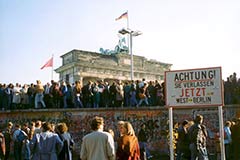
During the night of 9th November, 1989, the Berlin Wall was unexpectedly opened, following months of GDR citizens fleeing to the West via Hungary and the USSR. The whole city and Germany as a whole celebrated! From that moment on, the citizens of the GDR could once again travel freely.
Following the official reunification of Germany on 3rd October, 1990, Berlin was once again chosen as the capital city of Germany. Since 1999, Berlin is once again the seat of federal government and thereby the centre of German politics. As of 19th April, 1999, the parliament has held its meetings in the old Reichstag, which has been redesigned by Sir Norman Foster.
His glass dome became an attraction for Berliners and tourists from around the world. And in January 2000, the Sony Center was opened on the occasion of the Berlinale Film Festival and complements the completely remodelled Potsdamer Platz.
You can find out much more about the history of Berlin at •www.wikipedia.org
ALPADIA Berlin • D-10827 Berlin • Hauptstraße 23/24
+49 30 7811076 • • City Map & Route Planner
